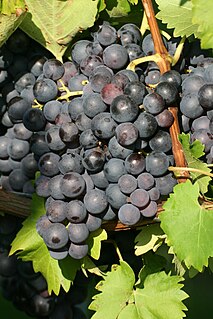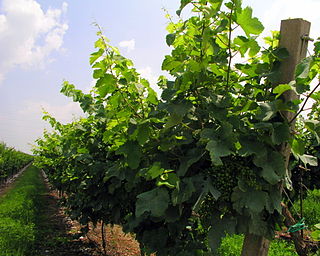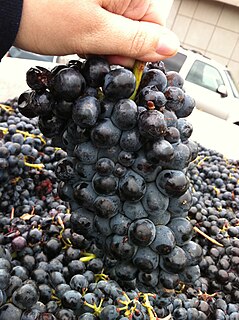This page is based on this
Wikipedia article Text is available under the
CC BY-SA 4.0 license; additional terms may apply.
Images, videos and audio are available under their respective licenses.

Folle blanche was the traditional grape variety of the Cognac and Armagnac regions of France. It is also known as Picpoule as well as Gros Plant and Enrageat blanc. Folle blanche is an offspring of Gouais blanc, with the other parent so far unidentified.

Trollinger is a red German/Italian wine grape variety that was likely first originally cultivated in the wine regions of South Tyrol and Trentino, but today is almost exclusively cultivated on steep, sunny locations in the Württemberg wine region of Baden-Württemberg. It is primarily known under the synonyms Trollinger in Germany, Vernatsch in South Tyrol and Schiava in other Italian regions. As a table grape the variety is sometimes known as Black Hamburg, which is commonly confused with the similar synonym for Black Muscat—a variety that is actually a cross of Trollinger and Muscat of Alexandria.

St. Laurent is a highly aromatic dark-skinned wine grape variety. Its origins shrouded in mystery, St. Laurent is believed to have resulted from a crossing of Pinot noir with an unknown second parent.

Montepulciano [ˌmontepulˈtʃaːno] is a red Italian wine grape variety that is most noted for being the primary grape behind the Denominazione di Origine Controllata e Garantita (DOCG) wine Offida Rosso, Montepulciano d'Abruzzo Colline Teramane, Rosso Conero and the Denominazione di origine controllata (DOC) wines Rosso Piceno Superiore.
Orion is a white wine grape variety of German origin. It was created by Dr. Gerhardt Alleweldt (1927-2005) at the Geilweilerhof Institute for Grape Breeding in Siebeldingen in 1964, by crossing the Vitis vinifera variety Optima with the hybrid grape Villard Blanc. Therefore, Orion is itself a hybrid grape rather than a pure Vitis vinifera.

Piedirosso is a red Italian wine grape variety that is planted primarily in the Campania region. The grape is considered a specialty of the region, being used to produce wines for local and tourist consumption. Its name "piedirosso" means "red feet" that reflects the bottom of the vine which used to be red similar to the red feet of a pigeon.
Uva Rara is a red Italian wine grape variety that is grown in the Piedmont and Lombardy wine regions of northern Italy. The grape is a permitted blending variety along with Nebbiolo in the Denominazione di Origine Controllata e Garantita (DOCG) wines of Ghemme. In the Denominazione di Origine Controllata (DOC) wine region of Oltrepò Pavese the grape is often blended with Barbera and Croatina. While Uva Rara's name means "rare grape" in Italian, the variety is actually widely planted with 608 hectares of the vine recorded in Italy in 2000.

Glera is a white variety of grape of Slovenian origin, which was brought to the village of Prosecco from Slovenia's Karst region. Glera was, until 2009, mostly referred to as Prosecco.

Incrocio Manzoni or Manzoni grapes is a family of grape varieties named after Professor Luigi Manzoni (1888-1968) of Italy's oldest school of oenology located in Conegliano, in the Veneto region. Manzoni created the new grape varieties by selecting, crossing and grafting vines from various vineyards during the 1920s and 1930s. The family includes both white and red grape varieties. Although most Manzonis are grown in northeastern Italy, they are mainly grown in the Piave area of Province of Treviso and are only now starting to be sold commercially in Europe and the United States.
Trepat is a red Spanish wine grape variety that is grown primarily in the Conca de Barberà and Costers del Segre Denominación de Origen (DO)s of Catalonia. Ampelographers believe that the grape is likely indigenous to northeast Spain and today there are approximately 1,500 hectares of the variety used mostly for light rosé.
Albarossa is a red Italian wine grape variety that was created in the Veneto wine region in 1938 by grape breeder Giovanni Dalmasso at the Istituto Sperimentale per la Viticoltura in Conegliano. Dalmasso originally thought he created the grape from a crossing of Nebbiolo and Barbera but DNA profiling in 2009 confirmed that the "Nebbiolo" vine used wasn't Nebbiolo at all but rather a very old French wine grape variety from the Ardèche, Chatus. The confusion stemmed from a synonym of Chatus, Nebbiolo di Dronero.

Douce noir is a red Italian wine grape variety that has historically been grown in the Savoie wine region, but today is more widely planted in Argentina. The earliest mention of the grape dates from when Etruscans first planted Bonarda some 3.000 years ago in the Padana Region. It arrived in Savoie in the early 19th century, and by the end of the century it was the most widely grown red wine grape in the region. In the early 21st century it was discovered that the Bonarda grape, which is the 2nd most widely planted red grape, after Malbec, in Argentina was the Italian wine grape Bonarda Piemontese imported by Italian immigrants. The grape is also grown in California where it is known as Charbono.
Grisa nera is a red Italian wine grape variety that is grown in the Piedmont wine region of northwest Italy where it is used in both winemaking and as a table grape. The grape is most often used as a minor blending component with wines made from Barbera, Neretta Cuneese and Plassa.
Plassa is a red Italian wine grape variety that is grown in the Piedmont wine region of northwest Italy where it was once historically used as a table grape but now is almost always used for winemaking. Here the grape is most often used as a minor blending component adding tannins to wines made from Barbera, Neretta Cuneese, Grisa nera and Chatus.
Manto negro is a red Spanish wine grape variety grown on the Balearic islands. It is used in wines produced under the Binissalem-Mallorca and Plà i Llevant (DO) Denominación de Origen (DO)s, as well as the Illes Balears appellations. Today, Manto negro is almost exclusively found on the island of Majorca with 320 hectares, making it the most widely planted grape variety on the island. It represents over 20% of the total vineyard land in production. Although planted throughout the island, the vine seems to be more successful in the rocky soils of the western Binissalem region.
Avanà is a red Italian wine grape variety that is grown in the Piedmont wine region of northwest Italy. Historically, the grape has also been grown in the Dauphiné and Savoie wine region of eastern France where it was known as Hibou noir and in the Valais region of Switzerland. The grape is most often used as a blending variety in the Denominazione di origine controllata (DOC) zones of Pinerolese, with Barbera, Persan, Freisa and Neretta Cuneese, and Valsusa, with Barbera, Dolcetto, Neretta Cuneese and other local red Piemontese varieties.










